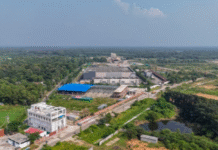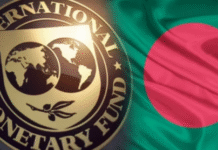Bangladesh Bank has projected that the growth of the country’s gross domestic product would be more than 7 per cent in the current fiscal year, but a negative growth in inward remittance and a moderate export growth might create downside risks.
The central bank made the projection in its quarterly (October-December of FY 2016-17) publication ‘Bangladesh Bank Quarterly’.
The government has set the GDP growth target at 7.2 per cent for FY17. In FY16, the country’s GDP growth was 7.1 per cent.
The BBQ publication for the first quarter (July-September) of FY17, however, had projected that the GDP growth would be in 7.1-7.3 per cent range in the current fiscal year.
In the second quarter of the FY17, economic activities witnessed a strong growth impulse, stemming mainly from the industry and the service sectors which would help to achieve more than 7 per cent GDP growth, the BBQ said.
The large- and medium-scale industries’ output registered a double digit (13.8 per cent in October, 2017) growth, aided by continued improvement in electricity supply and falling lending rates, it said.
Around 22 per cent growth in the number of cargoes handled through the Chittagong port, strong credit growth in the transport sector, and in trade and commerce (18.8 per cent and 11.7 per cent respectively) pointed to a robust growth of the service sector activities.
The agriculture sector also remained active, benefiting from benign weather condition and timely availability of agricultural inputs and credits.
From the demand side, expected growth of private sector credit and a fresh wave of capital machinery import indicated buoyant domestic demand.
The BBQ, however, said that the negative growth in the remittance inflow and a moderate growth in export earnings might have some dampening effect on the domestic demand.
The inward remittance decreased by $1.86 billion or 16.86 per cent in the July-March period of FY17 compared with the corresponding period of FY16 as the inflow dropped for the ninth month in a row this FY.
The country received $9.19 billion in remittance in July-March of FY17 against $11.05 billion in the same period of FY16.
The inward remittance significantly decreased in recent months as a good number of expatriate Bangladeshis sent their money by using illegal ‘hundi’ channel, according to a BB observation.
The current account balance recorded a deficit of $432 million in the second quarter of FY17.
The deficit was due largely to the negative growth of remittance inflow and a large deficit in the trade balance even though the trade balance deficit shrank in the second quarter of FY17 from the level of the first quarter of FY17, owing to the low growth of import payments, the publication said.
At the same time, low growth of exports was also suggesting weak external demand during the period under review, it said.
Country’s export earnings in the July-March period of FY17 increased by 3.97 per cent to $25.94 billion from $24.95 billion in the same period of FY16, the EPB data showed.
The movement of money market indicators loosely followed the programme path set in the monetary policy statement (MPS) for the first half of FY17, the BBQ said.
Despite a high growth in net foreign asset (18.1 per cent) and a satisfactory growth of private sector credit (15.6 per cent), the broad money (M2) growth (13.8 per cent) remained below the programme path due to the negative growth of credit to the public sector in the second quarter of FY17.
The banking sector indicators depicted a mixed picture in the second quarter of FY17 compared with that in the same quarter a fiscal year ago, the BBQ said.
Banks’ capital-risk weighted asset ratio and asset quality (in terms of both gross and net non-performing loans ratios) showed some improvements, while profitability and provision shortfall against classified loans deteriorated during the second quarter of FY17.
The central bank made the projection in its quarterly (October-December of FY 2016-17) publication ‘Bangladesh Bank Quarterly’.
The government has set the GDP growth target at 7.2 per cent for FY17. In FY16, the country’s GDP growth was 7.1 per cent.
The BBQ publication for the first quarter (July-September) of FY17, however, had projected that the GDP growth would be in 7.1-7.3 per cent range in the current fiscal year.
In the second quarter of the FY17, economic activities witnessed a strong growth impulse, stemming mainly from the industry and the service sectors which would help to achieve more than 7 per cent GDP growth, the BBQ said.
The large- and medium-scale industries’ output registered a double digit (13.8 per cent in October, 2017) growth, aided by continued improvement in electricity supply and falling lending rates, it said.
Around 22 per cent growth in the number of cargoes handled through the Chittagong port, strong credit growth in the transport sector, and in trade and commerce (18.8 per cent and 11.7 per cent respectively) pointed to a robust growth of the service sector activities.
The agriculture sector also remained active, benefiting from benign weather condition and timely availability of agricultural inputs and credits.
From the demand side, expected growth of private sector credit and a fresh wave of capital machinery import indicated buoyant domestic demand.
The BBQ, however, said that the negative growth in the remittance inflow and a moderate growth in export earnings might have some dampening effect on the domestic demand.
The inward remittance decreased by $1.86 billion or 16.86 per cent in the July-March period of FY17 compared with the corresponding period of FY16 as the inflow dropped for the ninth month in a row this FY.
The country received $9.19 billion in remittance in July-March of FY17 against $11.05 billion in the same period of FY16.
The inward remittance significantly decreased in recent months as a good number of expatriate Bangladeshis sent their money by using illegal ‘hundi’ channel, according to a BB observation.
The current account balance recorded a deficit of $432 million in the second quarter of FY17.
The deficit was due largely to the negative growth of remittance inflow and a large deficit in the trade balance even though the trade balance deficit shrank in the second quarter of FY17 from the level of the first quarter of FY17, owing to the low growth of import payments, the publication said.
At the same time, low growth of exports was also suggesting weak external demand during the period under review, it said.
Country’s export earnings in the July-March period of FY17 increased by 3.97 per cent to $25.94 billion from $24.95 billion in the same period of FY16, the EPB data showed.
The movement of money market indicators loosely followed the programme path set in the monetary policy statement (MPS) for the first half of FY17, the BBQ said.
Despite a high growth in net foreign asset (18.1 per cent) and a satisfactory growth of private sector credit (15.6 per cent), the broad money (M2) growth (13.8 per cent) remained below the programme path due to the negative growth of credit to the public sector in the second quarter of FY17.
The banking sector indicators depicted a mixed picture in the second quarter of FY17 compared with that in the same quarter a fiscal year ago, the BBQ said.
Banks’ capital-risk weighted asset ratio and asset quality (in terms of both gross and net non-performing loans ratios) showed some improvements, while profitability and provision shortfall against classified loans deteriorated during the second quarter of FY17.
Source: New Age









